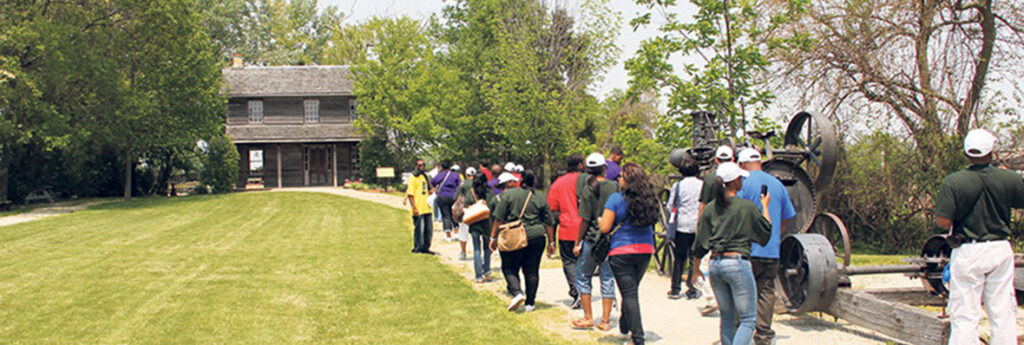As the world turns, and times change – it is to be hoped for the better, though at times that’s hard to imagine – I remembered a story I wrote a few years ago, after a trip through a lovely part of Ontario. The story was originally titled The Road that Led to Freedom and now that the Black Lives Matter movement is gaining so much traction I re-read the story and thought I would share it with you. And once we can travel freely again, I would like to think some Canadian travellers will follow in my footsteps and learn more of our history.
The region of which I write is known as Chatham-Kent, a municipality on the shores of Lake Erie, a few miles east of Detroit. It is an area of gently-rolling hills and prosperous farms, quaint towns and villages together with historic sites and museums. It is an area that holds a special place in our history as it tells the story of Canada’s place in the Underground Railroad.
Many Canadians know the story of the Underground Railroad, but perhaps it’s time to remember anew and to ensure we all know this important part of our history. The Underground Railroad was a network of escape routes for slaves stretching from the southern States north to Canada. Once across the border the slaves became free men and women. Those involved in helping people on this journey, and the slaves themselves, used a secret code: ‘stations’ were safe houses, ‘conductors’ were the guides, the refugees were referred to as ‘packages’, men were ‘hardware’, women ‘dry goods’ and children ‘baggage’. Canada was Caanan; the Ohio, Niagara and Detroit rivers were all the River Jordan; the Underground Railroad was ‘sweet chariot’ and ‘take me to freedom’ was sung as ‘carry me home’.
It is estimated that some 60,000 black freedom seekers arrived in Canada. Some returned to the United States after Abolition, but many remained and settled across Canada. And close to that border that they crossed so perilously to reach Canada, their descendants today protect the stories and artifacts that reveal their incredible history.
Twenty-nine historic sites commemorate Canada’s role in this exodus, routes extending from Windsor and Niagara to Owen Sound in the north. Sites include churches, schools, cabins, memorials, museums, cultural centres and more. Some fall under the Ontario Heritage Trust or National Historic Site umbrellas; others are maintained by communities. All are listed in an informative Ontario publication, A Visitor’s Guide to Ontario’s Underground Railroad.
In Chatham, black history is celebrated in the Heritage Room at the W.I.S.H. Centre where I watched a 22-minute video and met curator, Gwendolyn Robinson, great-great niece of Mary Ann Shadd, founder of an anti-slavery newspaper, The Provincial Freeman, published in Chatham from 1853 to 1860. As the first woman newspaper owner in Canada, the Visitor’s Guide states, “Many believe that Mary Ann Shadd’s model of tolerance and her passion for a fair and just society paved the way for the Canadian mosaic as we know it today.” Gwen further explained, “Most who came yearned for the education denied them in the US. After the Civil War, many black people who had been educated in Canada returned to the U.S. as doctors, lawyers, congressmen and judges and some started schools. And even before slavery was abolished some made the dangerous return to recruit soldiers to fight in the Civil War itself. It was illegal to recruit soldiers on British colonial soil to fight in foreign wars.”
South of Chatham, the tiny town of Buxton is home to the Buxton National Historic Site and Museum. In 1849, Reverend William King brought 15 slaves from Louisiana to Canada to establish the Elgin Settlement at Buxton, a self-sufficient community that grew to 300 inhabitants in six years. They voted out the incumbent M.P.P. who, two years previously, won his seat on an ‘anti-negro’ immigration platform. Over the ensuing years Buxton blossomed to a community of 2,000 black landowners and business people.
Shannon Prince, curator at this museum, works alongside assistant curator, Spencer Alexander. Both are sixth-generation descendants from slaves. Shannon’s husband, Bryan, won the Queen’s Golden Jubilee Medal for his contribution to black history as author of the book I Came as a Stranger.
In Dresden, north of Chatham, sits another historic site, one that has been heard of the world over, even if many believe it to be fictitious. It is known as Uncle Tom’s Cabin, home of Josiah Henson whose autobiography, written when he was 60, was the inspiration for Harriet Beecher Stowe’s anti-slavery novel, Uncle Tom’s Cabin, selling 300,000 copies its first year of publication. President Lincoln credited it as the catalyst for the American Civil War.
In his early 40s, Josiah Henson escaped from Kentucky with his wife and four children. Together with others who had escaped he purchased land and founded the British American Institute, one of the first black schools in Canada for vocational training whose graduates went on to ply their trades in local farms, mills and industries.
Today the five-acre site that is home to Uncle Tom’s Cabin celebrates the accomplishments of Josiah and his family as well as Harriet Beecher Stowe. There is an interpretation centre with an audio-visual presentation, a collection of 19th century artifacts and a collection of rare books of the abolitionist era. A restored period church also stands on the site together with a saw-mill, two cemeteries and, of course, the original Henson family dwelling now referred to as Uncle Tom’s Cabin.
When we can travel freely once again we may decide to stay in Canada for a while. So … bring your children and grandchildren to Chatham-Kent on a voyage of discovery that reveals Canada’s proud historic role in the Underground Railroad.

